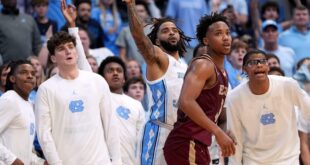The 50 NFL coaches and executives who voted in 2024 Quarterback Tiers did not for one second confuse the Miami Dolphins’ Tua Tagovailoa or the Jacksonville Jaguars’ Trevor Lawrence for the best QBs in the game.
They ranked Tagovailoa 15th and Lawrence 16th among 30 veterans at the position, placing them atop Tier 3 as win-with, not win-because-of quarterbacks. Good players. Promising. Not proven difference makers.
The balance sheet cannot distinguish them from future Hall of Famers.

GO DEEPER
NFL QB Tiers 2024: Only 2 join Mahomes in Tier 1; Rodgers, Herbert drop out
The $55 million-a-year contract extension Lawrence signed in the offseason made him the highest-paid quarterback in the league until Dak Prescott one-upped him over the weekend. The $53.1 million-a-year extension Tagovailoa signed has him solidly among the top five.
Awarding top-tier contracts to mid-tier quarterbacks wasn’t always as common.
From 2014 through ’22, Kirk Cousins was the only Tier 3 quarterback commanding contracts with average per year (APY) values worth at least 15 percent of the salary cap allotment for individual teams in the years the deals were signed. Cousins did it by reaching free agency, where he could solicit bids from desperate suitors.
Times have changed. In the last two years, the New York Giants (Daniel Jones), New Orleans Saints (Derek Carr), Jacksonville (Lawrence) and Miami (Tagovailoa) signed Tier 3 quarterbacks to extensions valued that high in relation to the cap. The deals for Lawrence and Tagovailoa carried APYs exceeding 20 percent of the cap.
The Giants, Jaguars and Dolphins all could have waited to see more from their QBs. Instead, they entered into expensive long-term relationships.

GO DEEPER
Which preseason Super Bowl contenders looked the part in Week 1? Sando’s Pick Six
“When people weren’t willing to make Daniel Jones play it out, that is when the world exploded,” a contract negotiator from an NFL team said. “We are not even talking Tua, who had huge production. We are talking Daniel Freaking Jones.”
It’s been a rough week for Jones, who tossed a pick-six interception during the Giants’ 28-6 defeat to the Minnesota Vikings. The point here is not to pile on. But at a time when more coaches can seemingly get great production from merely good quarterbacks, and when drafted quarterbacks enter the league on cost-controlled contracts, why are teams paying mid-tier veterans as if they were Patrick Mahomes?
“There has been such media pressure to just pay the guy,” a different negotiator said. “Way back, he wanted $2 million and you were offering $1.6 million. It made sense to say, ‘You know what, we ought to pay the guy — it’s not a big difference.’ But when you’re in the $50 million range and say, ‘Pay the guy,’ what does that mean? There has been groundswell of, ‘The market is the market’ and it is top of the market, even if you are not.”
The table below shows Cousins (shaded in orange) as the only quarterback outside Tiers 1 and 2 whose APY represented at least a 15 percent share of the salary-cap allotment in the year of signing, from 2014-22. His three contracts with Minnesota all qualified during that nine-season window.
QB deals with 15%+ average per year (APY)/cap, 2014–22
Cousins was the outlier, the rare veteran starting quarterback to reach the market. The remaining 24 deals in the table above went to quarterbacks voted into the top two tiers when the contracts were signed.
That is how life generally worked at the position, where Tier 1 and 2 quarterbacks are seen as the ones able to take their teams to Super Bowls without all-time great defenses on their side.
But as the table below shows, four of the 13 most recent qualifying contracts went to players seen by NFL coaches and executives as Tier 3 quarterbacks at the time of signing. That’s a shift.
QB deals with 15%+ average per year (APY)/cap, 2023–24
“Quarterbacks used to get paid for winning Super Bowls, not for having good regular-season stats,” another team exec said. “It was Steve Young, Dan Marino, John Elway, Tom Brady, Peyton Manning. Then, all of a sudden, I think it started right around Matthew Stafford with the Lions (in 2013), where it suddenly became, ‘Next man up.’”
Stafford entered the league in 2009, two years before the league and its players reduced salaries for highly drafted rookies. That meant Stafford and the Lions were negotiating in 2013 from a high salary floor. Before that extension, the Green Bay Packers paid Aaron Rodgers near the top of the market in 2008, after Rodgers had started less than one-half season. Rodgers had sat on the bench behind future Hall of Famer Brett Favre for three seasons, so he was deeper into his rookie deal.
Teams today are entering into top-of-market extensions with quarterbacks on cheaper rookie deals. They are doing these extensions one or two years before the players have any shot at free agency, and when teams could use the franchise tag to buy even more time for evaluation.
Teams can justify the approach to some degree by claiming that the extension, when tacked onto an existing deal with years remaining, lets them divide the new total over a longer period of time, lowering the average while locking in terms before prices climb. But they are still frequently committing massive amounts of money to less-than-elite quarterbacks when they could have waited.
Looking at all 37 deals in the tables above reveals a blurring of the lines between Tier 2 and 3 quarterbacks. Some of the QBs voted into Tier 2 at various points — Jimmy Garoppolo and Jared Goff come to mind, with Tagoavailoa right behind them atop Tier 3 this year — have looked really good and really bad for reasons having more to do with coaching and surrounding personnel.
“You have the struggle of, ‘Is Tua good or is (Dolphins coach) Mike McDaniel pulling the stings?” one of the contract negotiations said. “The owner says, ‘Well, I don’t know the difference.’ You are scoring points.
“Most of the coaches and GMs haven’t won enough to be able to tell their owners, ‘You know what? Let’s reset.”
San Francisco 49ers coach Kyle Shanahan, Los Angeles Rams coach Sean McVay and Philadelphia Eagles GM Howie Roseman had enough equity built up with ownership to move on from quarterbacks they had invested in heavily with massive contracts and/or expensive draft trades.
No one is saying the Dolphins should move on from Tagovailoa or the Jaguars should move on from Lawrence. But why couldn’t those teams push back on paying them at the top of the market? Why couldn’t they push for deals slotting those quarterbacks closer to where the league sees them?
“Tua has a sensational passing attack, a high level of success there,” one of the contract negotiators said. “Goff took Detroit, against a lot of people’s expectations, to the brink of the Super Bowl. I’m talking more about Derek Carr or Kirk Cousins, who have not had any real success in the playoffs and have not led Top 2-3 offenses.”
Money might not buy happiness, but it can buy peace between player and team, assuring that the quarterback will show up for training camp and participate. Tagovailoa and Green Bay’s Jordan Love reported for camp this summer, but withheld services until their extensions were signed. Their teams could have played hardball, but obviously did not see value in the fight.
For decision makers, telling ownership that the purported franchise quarterback is “the guy” and should be paid accordingly can feel safer than pointing out the quarterback’s limitations to save money. This could be especially true in an era when wealthier owners and ballooning salary caps have shaped a climate where teams are more willing to cut their losses, and where coaches might get only a couple of seasons to turn around a franchise.
“Everything in the NFL is about, ‘What helps me keep my job?’” one of the execs said. “It’s not about what is right. If I can pay a quarterback and two years from now move on and maybe not get blamed, that is better than going through a whole year of, ‘Are you going to pay him or not?’”
As the table below shows, the gap between Lawrence’s No. 16 ranking in 2024 Quarterback Tiers and his No. 2 APY represents the biggest deficit for any Tier 1-3 QB since 2014, the first year of QB Tiers. Tagovailoa just missed the cutoff this year with a minus-10 differential (No. 5 APY, No. 15 Tiers ranking).
“Worst” gaps between APY and Tiers ranks
The 49ers’ Brock Purdy, who is still playing on his seventh-round rookie contract, worth less than $1 million annually, represents the greatest surplus value since 2014 using this criteria. His No. 12 ranking in 2024 QB Tiers is 68 spots better than his No. 80 APY ranking among quarterbacks.
“Best” gaps between APY and Tiers ranks
Under NFL labor rules, Purdy becomes eligible to negotiate a long-term extension after the current season. He is the league’s No. 1 statistical quarterback since 2022 in expected points added (EPA) per pass play, passer rating and yards per pass attempt.
Coaches and executives think Purdy is a great fit for the star-studded 49ers, and a good player. The question is: How well would he fare with an average cast around him, or without Shanahan designing the offense? Coaches and execs don’t think Purdy will ever be able to carry a team the way Mahomes or the Buffalo Bills’ Josh Allen can.
Recent history says none of that will matter when it comes time for a new contract. Purdy has already climbed into Tier 2, and he does not appear finished rising. The league will not blink if and when he passes Prescott or whoever else happens to be the NFL’s highest-paid quarterback at the time.
(Illustration: Dan Goldfarb / The Athletic; photos: Ric Tapia and Mitchell Leff / Getty Images)
Source link
 meganwoolsey Home
meganwoolsey Home



